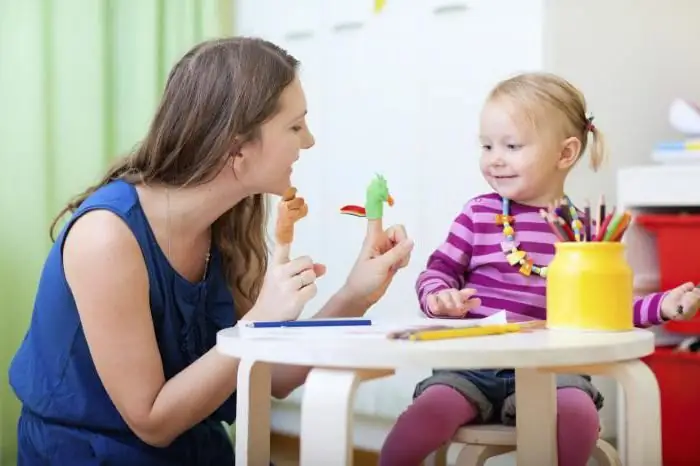2026 Author: Priscilla Miln | [email protected]. Last modified: 2025-06-01 05:14:29
The daily routine in the preschool educational institution is almost the same for all state kindergartens that implement the classical general education program. This is done for a reason, but to facilitate the process of adaptation of the baby and accustom him to self-organization.

Psychological factor
The period when a child is just starting to go to kindergarten is very difficult - every parent knows about it. Not all children get used to a new team, unusual environment, new types of activity smoothly and quickly. In most cases, babies will adapt in at least a couple of months, or even longer.
To facilitate a long and difficult process for a child's body, a special regime is organized. Moreover, it is important to coordinate the daily routine of the child in kindergarten in such a way that it coincides with the biorhythms and needs of the baby himself.
What should be considered when compiling a daily routine?
The life of any person is subject to cyclicity. The order of the day for each of us is the sequence of sleep and wakefulness, decrease and increase in activity. Daily routine in preschoolGEF takes into account the physical and mental performance of a little man. The time of eating, active games, daytime sleep is carefully calculated, the optimal time for children to stay in the group and in the fresh air is calculated. Of course, this is also affected by the time of year and the age of the babies.

The daily routine is regulated by many rules and sanitary and epidemiological requirements. Everything is being checked, from the organization of the institution to the conditions for keeping children and the organization of the working hours of the staff.
Requirements for the organization of the daily routine in the kindergarten
- The harmonious development of children and their age-appropriateness are the main criteria that the day regimen in kindergarten must meet.
- The duration of daytime wakefulness for the younger group is set individually, according to medical recommendations. For older groups, it is from 5 to 6 hours. Quiet hours are set accordingly.
- Walking is an essential part of the Kindergarten routine. It is better if they are as long as possible in the fresh air - up to 3-4 hours in the warm season. Usually educators take the children for a walk twice a day: after breakfast and after a nap. In winter, with strong winds and frost below -15, walks become shorter or not carried out at all.
- Daytime naps in the nursery should last at least three hours. For preschool groups, this is 2-2.5 hours. Moreover, the educator must plan the daily routine in such a way that immediately before going to bed there are no outdoor games that willpromote hyperactivity and disruption of rest.
- An important part of the routine is playing or educational activities. In total, it takes 3 to 4 hours. Of course, preparation for school and classes should not be held in a row, but with breaks - at least 10 minutes. During such a break, you can spend a physical education minute. Educational activity causes increased mental stress, so it is best to do it in the morning, when the child's performance is higher.
- After sitting up for games or activities, children should relax and throw out the stress. Therefore, physical activity is only welcome. There is often exercise in kindergarten with music, which contributes to greater organization and raising the mood of the kids.

To each his own regime
Daytime at preschool may vary depending on various factors. For example, by age, weather conditions or during quarantine. There are also adaptive and sparing modes. In some cases, it is even assigned individually.
Weather conditions
In bad weather, the regime may change radically. The time of the walk shifts, its duration decreases. While the physical activity of children in the room, on the contrary, increases. They are engaged not only in groups, but also in gyms, music rooms, educational studios, etc. It is important to use all the premises in the preschool educational institution to the maximum so that all pupils are busy.

Adaptation and gentle treatment
Every child goes through an adaptation period when they enter kindergarten. Some have more, some have less. The duration of this period is set individually by the doctor or agreed with him. During this time, the child is in the kindergarten, at first at a minimum, then with a gradual increase in time. Educational activities are not carried out at this stage, maximum attention is paid to joint games, walks and daytime sleep. The main thing here is that the baby should not harm the psyche and adapt to new conditions for him as soon as possible, get to know his peers, get used to the teachers and receive only positive emotions from being in kindergarten.

A sparing day regimen in the kindergarten is set for kids who come after an illness. For them, it is recommended to reduce the time spent in the kindergarten, reduce the educational load or do classes at the request of the child. The baby is also freed from physical education. An exception may be charging in kindergarten to the music, if it causes positive emotions in the child himself. Sleep hours increase, that is, the child wakes up later than others. And the thermal regime is necessarily observed: for example, a baby on a “sparing” mode will walk less, dress last for a walk, and undress first.
Quarantine
At the time of quarantine, the schedule is agreed with the doctor and depends on the type of disease. So, contact with other groups of the kindergarten is excluded, a thoroughventilation and sanitization of the premises, the time for walking increases, and the time for classes is reduced.
Custom Mode
It can be prescribed to such children, as, for example, after a serious illness, a long stay in a sanatorium or on vacation. And also for babies with individual he alth problems, on the recommendation of specialists. For them, hours of quiet time increase, mental stress is reduced, special conditions for walking are created, and the total time spent in the garden is reduced.

The general daily routine of a typical kindergarten is something like this:
- At 8:00-8:15 (until 8:30), parents bring their children.
- Kindergarten breakfast at 8:30.
- One hour, from 9 to 10, is devoted to studying or getting ready for school.
- Before lunch, that is, until 12 o'clock, the kids walk - in the warm season in the fresh air, in winter they play in a group.
- Lunch is served from 12 to half past one. Then the preparation begins and laying down for a daytime sleep.
- 13:00-15:00 - sleep hours.
- From 3:30 p.m. to 4:00 p.m., there is an afternoon snack, and then classes or a walk for the rest of the day.
A properly organized day regimen in a preschool educational institution is the key to a comfortable stay of the child and his optimal development. It is important for both educators and parents to remember this.
Recommended:
Types of classes in preschool. Organization of children in the classroom. Lesson Topics

In the article, we will consider the types of classes in preschool educational institutions, what forms of organization of children are used, how to attract children so that they are happy to perceive new knowledge and at the same time do not consider classes hard work. We will also explain the purpose for which educators analyze their classes, what this form of work gives them. You will find out what parts the classes consist of, how the educational process differs in the younger and older groups of the kindergarten
Speech therapy classes for children (2-3 years old) at home. Speech therapist classes with children 2-3 years old

When a child at 2-3 years old does not speak, parents panic. It seems to them that if the neighboring children speak very well, then their baby is lagging behind in development. However, it is not. Speech therapists say that each child is individual. Non-speaking children can be taught at home. In this article, you can find exercises, tips and tricks that will help keep your child interested
Classes in the preparatory group for GEF. Classes in drawing, ecology, the world around

Classes in the preparatory group should prepare the child for school. The best way is to learn by playing. This opportunity is provided by new standards of education
Breakfast for kids. What to cook for a child for breakfast?

Human nature is such that immediately after waking up, he does not want to eat. By the way, this applies not only to people, but also to animals. A piece of food must first be obtained, and then eat it. So there is nothing surprising in the fact that your child refuses to eat in the morning. In this article, we will consider not only what to cook for a child for breakfast, but how to help him eat it with pleasure and benefit for the body
Daily routine in the GEF preparatory group. Gymnastics, walks, quiet time, games

Daily routine in the GEF preparatory group, its features. Fulfillment of regime moments as a guarantee of proper work in kindergarten

